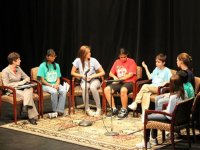Planning for Engagement: 6 Strategies for the Year
Over the summer, I offered to help some friends convert their dining room light fixture into a ceiling fan. Once the electricity was off, the old fixture was down, and I'd opened the large cardboard box, my goal was clear and pressing. This needed to be accomplished before people began to arrive for the five-year-old's birthday party that would begin in two hours. There was no need to remind myself to focus or pay attention.
After about half an hour, my arms had become heavy from holding pieces up while perching on the ladder, but my mind was interested only in the process. I opened the old switch plate on the wall and skipped a breath when I saw what was inside. There were more than two black wires. Because the fan was controlled by a special switch that was not compatible with the current circuit, I had to figure out how to change the wiring to a single pole. I took a brief pause to take in the scene: the table was pushed to the side of the room, the drop cloth and ladder were covered with tools and fan parts. Without wasting any more time, I dashed toward the computer to learn what I needed in order to proceed.
Creating Engagement
Sadly, moments of full immersion are not the memories that most of us have from our years as students. It is clear that schools -- and learning -- are more powerful and effective when students are deeply connected to their work. What would it take for students to regularly experience the kind of engagement where they are fully immersed and "lost" in their tasks?
Learning that leads to deep engagement should be thoughtfully and carefully structured to work for many different types of learners. One of the wonderful challenges of our craft is to structure learning so that it draws in young people with many different interests, abilities and skill levels.
My experience with the fan involved a project with a clear final product. I was motivated to succeed and had a deadline. I encountered a challenge midway and needed to research in order to problem solve. Past experiences had taught me how to quickly find the information that I needed to move forward with the project.
Similarly, deep student engagement usually requires a challenge of creating something or figuring something out. Students also often need assistance or modeling along the way to help them overcome obstacles and challenges or to improve the quality of their work. Engagement is usually lost when learners are asked to figure things out on their own and don't have the tools, experience or problem-solving skills to proceed.
An Action Plan for the Year
When I plan for my classes, I first think about desired outcomes for my students before I design specific units and lessons. This process, which Grant Wiggins and Jay McTighe explain in Understanding by Design, has helped me not only as a curriculum designer but also as a professional with larger goals of growth.
Each new school year is an opportunity for me to develop new skills and try out different strategies with my classes. Throughout this year I want to use backward design to plan for deeper student engagement. I've come up with a list of six different strategies that I'll refer to regularly as I plan my courses:
1. Authentic Learning
I strive to find ways to have my students do work that has meaning in the world, beyond classroom walls. As I plan, I will attempt to always have a rationale for learning content and a clear reason for doing the work that we do. In the past, I've had success designing projects that grapple with current issues or are created for an outside audience.
2. Inquiry
Just like I noticed during my own process with the fan, I want to remember that learning is most powerful when it's a process of investigation and discovery. I want to be sure that my students regularly experience the power of these processes, and that I do what is necessary to make this possible.
3. Collaboration
Collaboration makes me a better teacher. I want to find ways to set up new collaborations with both teachers and organizations.
4. Integrating the Arts
We are all creative beings, and when I structure learning and projects well, all students feel excited about expressing their ideas creatively.
5. Presentation & Performance
Engagement is greater when students are creating work that has a wider audience. Whenever possible, I want students to present and/or perform their work. Sometimes this can mean presenting or performing for the class, and at other times I want to find interested or relevant audiences that can witness and respond to student work. (Here is an example of a student project posted to YouTube.)
6. Integrating Technology
When I am smart and strategic about how I integrate technology into my classroom, it allows my students to make their work stronger and reach larger audiences. (Here is an example of a student paper posted to a blog with an accompanying digital story.) I want to make sure that when I use technology, it is for a clear purpose and helps me achieve the goals above -- and my larger goal of increased engagement.
This summer, I was reminded that deep engagement is a powerful process that all learners should be able to experience. As educators, it is important that we continually strive to find new ways of helping students discover their passions and abilities so that they can become truly immersed in the joys and struggles of learning and growing.
